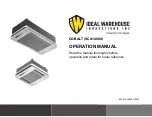
STEP 3: FLARE PIPE ENDS
Proper flaring is essential to achieve an airtight seal.
• After removing burrs from cut pipe, seal the ends
with PVC tape to prevent foreign materials from
entering the pipe.
• Sheath the pipe with insulating material.
• Place flare nuts on both ends of pipe. Make sure
they are facing in the right direction, because you
can’t put them on or change their direction after
flaring. See
FIG. 5.3
.
• Remove PVC tape from ends of pipe when ready
to perform flaring work.
• Clamp flare form on the end of the pipe. The end
of the pipe must extend beyond the edge of the
flare form in accordance with the dimensions
shown in the table below.
PIPING EXTENSION BEYOND FLARE FORM
• Place flaring tool onto the form.
• Turn the handle of the flaring tool clockwise until
the pipe is fully flared.
• Remove the flaring tool and flare form, then
inspect the end of the pipe for cracks and even
flaring.
STEP 4: CONNECT PIPES
When connecting refrigerant pipes, be careful
not to use excessive torque or to deform the
piping in any way. You should first connect the
low-pressure pipe, then the high-pressure pipe.
MINIMUM BEND RADIUS
When bending connective refrigerant piping, the
minimum bending radius is 10cm/4"(See
FIG. 5.6
).
INSTRUCTIONS FOR CONNECTING PIPING
TO INDOOR UNIT
• Align the center of the two pipes that you will
connect (See
FIG. 5.7
).
• Tighten the flare nut as tightly as possible by hand.
• Using a spanner, grip the nut on the unit tubing.
• While firmly gripping the nut on the unit
tubing, use a torque wrench to tighten the flare
nut according to the torque values in the
Torque
Requirements table
(next page). Loosen the
flaring nut slightly, then tighten again.
≥10cm/4”
Radius
Outer Diameter of
Pipe (mm)
A (mm)
Min.
Max.
Ø 6.35 (Ø 0.25”)
0.7 (0.0275”)
1.3 (0.05”)
Ø 9.52 (Ø 0.375”)
1.0 (0.04”)
1.6 (0.063”)
Ø 12.7 (Ø 0.5”)
1.0 (0.04”)
1.8 (0.07”)
Ø 16 (Ø 0.63”)
2.0 (0.078”)
2.2 (0.086”)
Ø 19 (Ø 0.75”)
2.0 (0.078”)
2.4 (0.094”)
FIG. 5.3
FIG. 5.5
FIG. 5.4
FIG. 5.8
FIG. 5.6
FIG. 5.7
cm
Flaring tool
sold separately







































